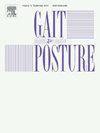To see or not to see: Does foot visualization in immersive virtual reality influence gait parameters of youths with neuromotor impairments when performing walking-related activities?
IF 2.2
3区 医学
Q3 NEUROSCIENCES
引用次数: 0
Abstract
Background
Immersive virtual reality (VR) experienced through a head-mounted display (HMD) offers the possibility to practice real-world situations in a safe and motivating way in pediatric neurorehabilitation. As the HMD blocks the view of the physical world, patients lack visual feedback of their body parts. Foot visualization in the virtual environment could inform patients about their feet’s position during walking-related activities.
Research question
How does foot visualization affect spatial gait parameters of youths with neuromotor gait impairments during everyday walking tasks with an immersive VR-HMD?
Methods
In this cross-sectional study, 15 youths with neuromotor gait impairments (mean age 12.3 years) performed four walking-related tasks wearing the VR-HMD Meta Quest 2. Walking through the virtual environment, they had to place their feet as accurately as possible on bollards, step over a plank, balance over a beam, and cross a gap. We used a Vicon motion capture system to assess spatial gait parameters when the participants could not see their feet and when a real-time virtual model of their feet was integrated into the virtual environment.
Results
In the bollard task, foot visualization had a large positive effect (Hedges’ g = 0.82) on the foot placement accuracy, with a reduction in deviation from the bollard center from 12.1 cm (IQR: 16 cm) to 6.5 cm (IQR: 5.1 cm) (p < 0.001). Further, the maximum step height of the leading foot when overstepping the plank decreased by 2.9 cm (g = 0.4, p = 0.05). Foot visualization did not influence the spatial gait parameters when balancing over a beam or crossing a gap.
Significance
Pediatric patients who practice walking-related activities with an immersive VR-HMD can benefit from foot visualization, as it increases foot placement accuracy for certain tasks. However, technical solutions have to become simpler for the clinical implementation of foot visualization.
看还是不看:沉浸式虚拟现实中的足部可视化是否会影响神经运动障碍青少年在进行步行相关活动时的步态参数?
通过头戴式显示器(HMD)体验的沉浸式虚拟现实(VR)提供了在儿童神经康复中以安全和激励的方式练习真实情况的可能性。由于HMD阻挡了对物理世界的观察,患者缺乏对身体部位的视觉反馈。在虚拟环境中的足部可视化可以告诉患者在步行相关活动中他们的脚的位置。研究问题:足部可视化如何影响青少年神经运动步态障碍患者在使用沉浸式VR-HMD时的空间步态参数?在这项横断面研究中,15名患有神经运动步态障碍的青少年(平均年龄12.3岁)佩戴VR-HMD Meta Quest 2完成了四项与步行相关的任务。在虚拟环境中行走时,他们必须尽可能准确地将脚放在护柱上,跨过木板,在横梁上保持平衡,并穿过间隙。我们使用Vicon动作捕捉系统来评估参与者在看不见他们的脚以及将他们的脚的实时虚拟模型集成到虚拟环境中时的空间步态参数。结果在柱柱任务中,足部可视化对足部放置精度有较大的积极影响(赫奇斯的g = 0.82),与柱柱中心的偏差从12.1 cm (IQR: 16 cm)减少到6.5 cm (IQR: 5.1 cm) (p <; 0.001)。此外,当超越木板时,领先脚的最大台阶高度降低了2.9 cm (g = 0.4,p = 0.05)。当在横梁上保持平衡或穿过间隙时,足部可视化并不影响空间步态参数。使用沉浸式VR-HMD进行步行相关活动的儿科患者可以从足部可视化中受益,因为它提高了某些任务的足部放置准确性。然而,对于足部可视化的临床实施,技术解决方案必须变得更简单。
本文章由计算机程序翻译,如有差异,请以英文原文为准。
求助全文
约1分钟内获得全文
求助全文
来源期刊

Gait & posture
医学-神经科学
CiteScore
4.70
自引率
12.50%
发文量
616
审稿时长
6 months
期刊介绍:
Gait & Posture is a vehicle for the publication of up-to-date basic and clinical research on all aspects of locomotion and balance.
The topics covered include: Techniques for the measurement of gait and posture, and the standardization of results presentation; Studies of normal and pathological gait; Treatment of gait and postural abnormalities; Biomechanical and theoretical approaches to gait and posture; Mathematical models of joint and muscle mechanics; Neurological and musculoskeletal function in gait and posture; The evolution of upright posture and bipedal locomotion; Adaptations of carrying loads, walking on uneven surfaces, climbing stairs etc; spinal biomechanics only if they are directly related to gait and/or posture and are of general interest to our readers; The effect of aging and development on gait and posture; Psychological and cultural aspects of gait; Patient education.
 求助内容:
求助内容: 应助结果提醒方式:
应助结果提醒方式:


